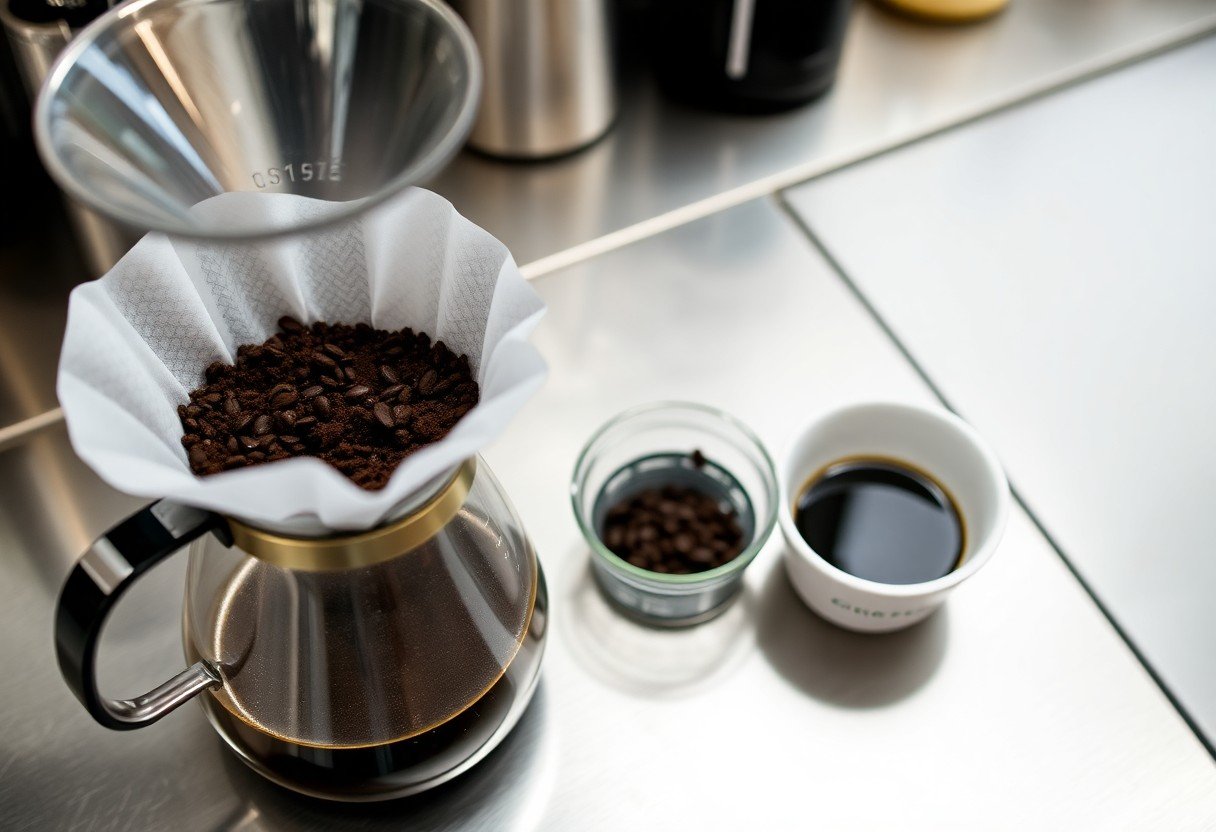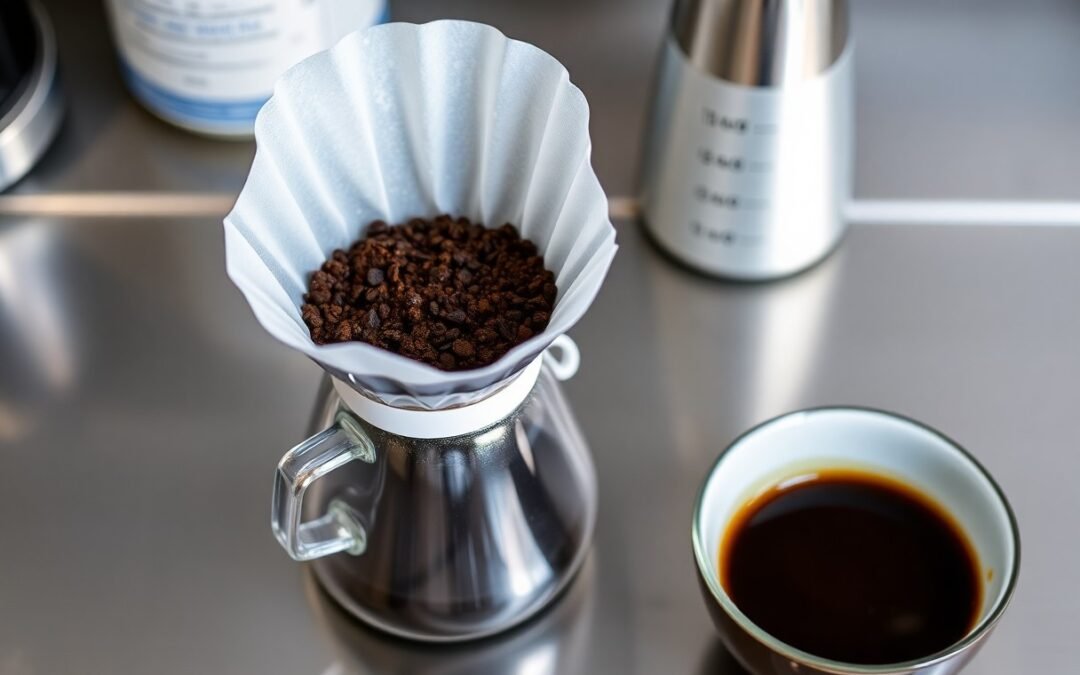It’s possible to elevate your coffee experience by tapping into umami undertones while brewing indoors. With the right techniques and ingredients, you can unlock a depth of flavor that transcends traditional coffee profiles. This guide will explore methods to enhance umami in your cup, ensuring you enjoy a refined and satisfying brew at home. You’ll discover how to select the right beans, adjust your brewing methods, and appreciate the complexities of flavor that umami brings.

The Flavor Spectrum: Understanding Umami
Umami, often described as a savory fifth taste, enriches flavor profiles by adding depth and complexity. This elusive component emerges from compounds like glutamate, prevalent in ingredients such as mushrooms, tomatoes, and aged cheeses. Incorporating umami in your brewing practices can transform standard coffee into a nuanced experience, creating layers that engage your palate and elevate your overall tasting journey.
Defining Umami and Its Role in Flavor Profiles
Umami shapes the essence of many flavor profiles, acting as a balancing agent that enhances sweetness and counters bitterness. Found naturally in various foods, it creates rich, satisfying experiences that linger on your palate. When brewing, understanding umami can influence the selection of beans and brewing methods, allowing you to craft a refined cup that highlights these savory nuances.
The Science of Umami: How It Interacts with Other Tastes
Umami interacts with sweetness, sourness, and bitterness to create a more harmonious flavor profile. For instance, in the presence of sweetness, umami compounds can deepen the taste experience, while also softening sharp edges from acidity. Combining brews with umami-rich additives like cocoa or nut milk accentuates these flavors, inviting a robust taste that elevates your coffee beyond the ordinary.
This interaction is largely due to the way umami compounds signal the body’s appetite for protein, enhancing flavors that satisfy and complement each other. For example, the natural sweetness found in certain coffee beans can be amplified when brewed alongside umami-loaded ingredients like miso or even a dash of soy sauce, creating unexpected yet delightful flavor combinations. Understanding how umami plays with other tastes in your cup will refine your brewing approach, transforming each sip into a well-rounded, flavorful experience.

Brewing Techniques to Maximize Umami Undertones
To truly unlock umami undertones in your coffee, specific brewing techniques play a pivotal role. Focus on extraction methods that enhance the savory qualities of the beans. Techniques like pour-over, immersion, and cold brew can be particularly effective, allowing you to manipulate variables such as temperature and time for optimal flavor development. Experimenting with water quality and mineral content can also influence the richness and depth of umami in each cup.
Choosing the Right Beans: Varietals that Emphasize Umami
Selecting beans with naturally high umami qualities can significantly enhance your brewing experience. Look for varietals like Sumatra Mandheling or Ethiopian Yirgacheffe, known for their rich body and savory notes. Beans processed using the wet method often retain more innate umami, delivering a deeper flavor profile. Sourcing from regions with volcanic soil can further elevate the umami potential, thanks to the mineral-rich environment that nourishes the coffee plants.
Grind Size and Brewing Time: Optimal Conditions for Umami Extraction
The grind size and brewing time directly affect how effectively umami is extracted from your coffee. A medium-coarse grind often works best for methods like pour-over or French press, allowing enough surface area for extraction while preventing over-extraction, which can lead to bitterness. Brewing times typically range from three to four minutes for pour-over and up to five minutes for immersion methods. Fine-tuning these variables ensures a balanced cup that showcases umami without compromising other flavor notes.
To refine the umami extraction process further, focus on consistency in grind size, as too fine a grind can lead to rapid extraction and unwanted bitterness. Start with a brew time of around four minutes, adjusting as necessary based on taste. Water temperature between 195°F and 205°F generally yields optimal results, enhancing savory notes while preserving sweetness. Regularly tasting your brew can guide you in making adjustments, allowing you to dial in the perfect balance of flavors that highlight the rich umami undertones in your cup.
The Art of Water: Enhancing Umami Through Mineral Content
Water’s mineral content significantly influences the extraction of umami flavors in your brew. Minerals like magnesium, calcium, and sodium not only affect the taste but also enhance aroma and mouthfeel, creating a well-rounded cup. Adjusting these levels according to your chosen coffee beans can amplify the umami profile, ultimately creating a more delightful and refined experience indoors.
The Chemistry Behind Brewing Water: pH and Mineral Balance
Your brewing water’s pH and mineral balance shape the extraction process. Ideal water pH ranges from 6.5 to 7.5, promoting optimal solubility of compounds from coffee grounds. A higher calcium level enhances sweetness and smoothness, while magnesium contributes to flavor clarity. Such adjustments lead to a more complex taste, elevating umami characteristics in your cup.
Water Temperature: Finding the Sweet Spot for Flavor Nuances
Brewing temperature directly impacts the extraction of flavors, particularly umami notes. Aim for a water temperature of 195°F to 205°F (90°C to 96°C) to efficiently dissolve soluble compounds. Lower temperatures may lead to under-extraction, while higher temperatures could extract undesirable bitter flavors, disrupting the delicate balance of your brew.
Water Temperature Influence
| Temperature (°F) | Extraction Effects |
|---|---|
| 190°F | Under-extraction, muted flavors |
| 200°F | Optimal extraction, balanced flavors |
| 210°F | Over-extraction, bitterness |
Finding the right brewing temperature allows you to uncover the full spectrum of flavors. Water at 200°F facilitates proper extraction, drawing out the intricate umami flavors while maintaining the overall balance. Next time you brew, experiment with slight temperature adjustments to see how they affect flavor clarity, leading to a more refined, umami-rich cup tailored to your preference.
Temperature Impact on Umami Extraction
| Temperature Range | Flavor Extraction |
|---|---|
| 195°F – 205°F | Maximized umami and sweetness |
| Below 195°F | Less umami, flat profile |
| Above 205°F | Increased bitterness, diminished sweetness |
Sensory Elements: Creating a Multi-Dimensional Coffee Experience
Exploring coffee’s sensory elements enriches your brewing journey, transforming a simple cup into an extraordinary experience. By focusing on aroma, texture, and flavor pairing, you can unlock new layers of umami and create a well-rounded coffee that delights the palate. Engaging multiple senses allows for a deeper appreciation of each sip, enhancing both enjoyment and appreciation of your brew. Mastering these elements introduces complexity, turning everyday routines into memorable moments.
Aroma and Texture: How to Elevate the Umami Experience
To fully appreciate umami, focus on the coffee’s aroma and texture. Experiment with different brewing methods, such as pour-over or French press, which can encourage the extraction of rich, savory notes. Swirling your cup can release aromatic compounds, enhancing your sensory engagement. The texture also plays a significant role; aiming for a creamy mouthfeel, achieved through optimal grind size and brew temperature, allows umami flavors to shine through, offering a luxurious drinking experience.
Pairing Flavors: Complementing Your Cup with Food
Pairing your coffee with thoughtfully chosen foods elevates the overall flavor profile, enhancing the umami notes in your brew. Consider ingredients that possess similar savory qualities, such as dark chocolate, nuts, or certain cheeses. These accompaniments can harmonize with the coffee’s inherent flavors, creating a balanced and fulfilling tasting experience. For instance, a medium roast paired with a sharp cheddar can reveal unexpected depth, while a dark chocolate pairing can underscore the coffee’s subtle sweetness.
Experimentation and Refinement: The Path to Your Ideal Brew
Finding your ideal brew involves continuous experimentation and refinement. Adjusting variables like grind size, water temperature, and brew time can unlock distinct umami flavors, leading to a more sophisticated cup. This process invites you to taste, analyze, and tweak each component until the balance aligns perfectly with your palate, creating an enriching sensory experience.
Tasting Methodology: Keeping Accurate Notes for Improvement
Accurate note-taking during your brewing sessions enables you to track the nuances of each attempt. Document variables such as coffee type, grind size, brewing time, and water quality alongside flavor notes. This information creates a comprehensive repository, making it easier to identify patterns that contribute to or detract from your desired umami undertones, ultimately guiding you toward a superior brew.
The Role of Feedback: Collaborating with Fellow Coffee Enthusiasts
Engaging with fellow coffee enthusiasts opens up new perspectives that enhance your brewing skills. Sharing your experiences and inviting critique can lead to insightful discussions about techniques and flavors, facilitating growth in your brewing practice. Through tasting sessions or online coffee forums, exchanging ideas fosters a collaborative environment that encourages deeper exploration of umami characteristics in your coffee.
Engaging with a community of coffee enthusiasts provides opportunities for collective experimentation. Sharing brews and tasting notes can reveal preferences you might not have discovered alone. Perhaps your neighbor’s method of varying brew time results in a richer umami profile that you can adopt. Additionally, feedback sessions often introduce you to distinct coffee varieties or preparation methods you haven’t tried, further diversifying your brewing repertoire.
Summing up
To wrap up, harnessing umami undertones while brewing indoors requires careful selection of ingredients and techniques. You can enhance your cup by choosing high-quality beans and experimenting with brewing methods like pour-over or French press. Pay attention to water temperature and steeping time, as these factors significantly influence flavor extraction. With a focus on sourcing and preparation, you can refine your brewing process to achieve a richly layered cup that highlights those savory notes.
FAQ
Q: What is umami, and how does it relate to brewing coffee indoors?
A: Umami is one of the five basic tastes, often described as savory. In coffee, umami undertones can enhance the flavor profile, contributing to a richer, more complex cup when brewing indoors.
Q: What brewing methods best capture umami flavors indoors?
A: Methods such as pour-over, French press, and siphon brewing are effective for highlighting umami flavors. These techniques allow for greater control over extraction and temperature, important for maximizing flavor nuances.
Q: How can I select coffee beans that emphasize umami undertones?
A: Look for beans sourced from regions known for their savory profiles, such as certain varieties from Asia. Beans that are medium to dark roasted often retain more umami characteristics, making them suitable for this purpose.
Q: Does water quality impact the umami flavors in brewed coffee?
A: Yes, the quality of water used can significantly affect extraction. Use filtered water free of impurities, as it allows the coffee’s natural flavors, including umami, to shine through without interference from unwanted tastes.
Q: Can brewing temperature affect umami extraction?
A: Absolutely. Brewing at the ideal temperature range of 195°F to 205°F (90°C to 96°C) helps achieve balanced extraction, promoting the development of umami notes while avoiding bitterness.

